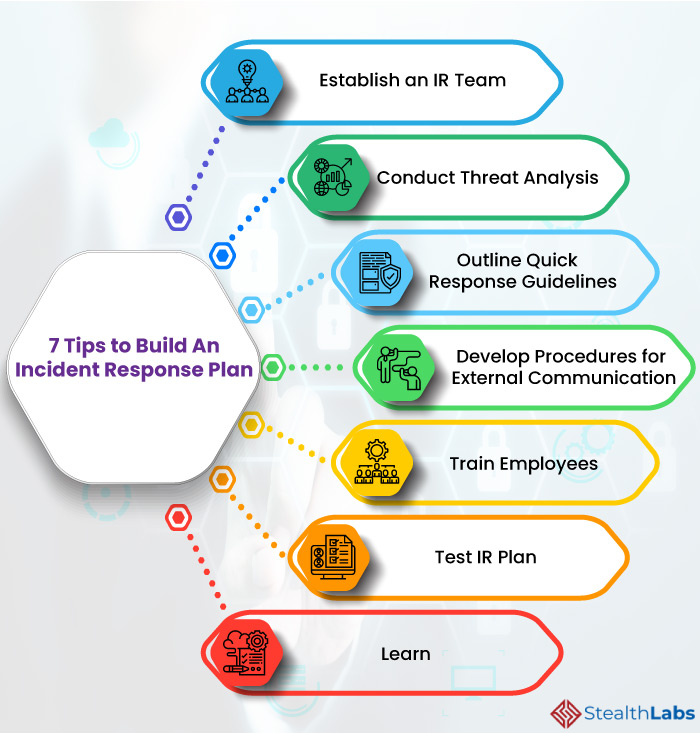Cyberthreats have proliferated rapidly in recent years. With sophisticated, complex, and adaptive versions of cyberattacks coming up, threat detection has become more challenging than ever. In addition to this, the remote working, cloud migration, IoT, BYOD, and hybrid environments have further expanded the threat landscape.
As cyber-attacks become inevitable, developing an effective Cyber Incident Response Plan (CIRP) has become essential for businesses that seek to stay ahead of adversaries.
Incident Response Plan (IRP) enables organizations to prepare for the inevitable, respond effectively to evolving threats, and recover thoroughly when attacks occur.
Here are seven tips to help your organization develop and implement an effective incident response plan:
7 Tips to Build An Incident Response Plan

1) Establish an IR Team
Form an incident response team and clearly define each team member’s roles and responsibilities to ensure a proper and consistent response to threats. There are various types of IR teams, including internal, external, or a mixture of both.
The IR team should comprise experts from breach management, threat intelligence, malware analysis, forensics, and incident detection.
The IR team analyzes security breaches and threat intelligence reports to help develop the organization-wide incident response strategy.
2) Conduct Threat Analysis
Determine what criteria, a specific security issue, an attempted attack, or a cumulative set of circumstances, is defined as a security incident.
Once defined, conduct an incident threat analysis to baseline and benchmark your current readiness to respond and identify incidents. Then, make the necessary improvements to your organization’s current security measures.
3) Outline Quick Response Guidelines
Based on the incident threat analysis, develop a quick-response guidebook for the most common security incidents. This will help the IR team to respond promptly to the most common attacks that threaten your organization.
Moreover, outline step-by-step procedures and processes for making critical incident response decisions and define who will be responsible for these decisions.
4) Develop Procedures for External Communication
Communicating with your partners, customers, and investors during an incident plays a critical role in maintaining customer trust and brand reputation.
Around 35% of customers reportedly gain trust in an organization if they are appropriately informed about a breach.
Therefore, ensure to document communication procedures to notify potential customers and stakeholders about the incident. It is also beneficial to communicate with external breach responders and other experts to receive further guidance for handling the incident.
5) Train Employees
Employees of your organization are an essential component of a cyber incident response plan. Ensure that all employees are aware of the IR plan and have access to it. Moreover, train them to understand their roles and carry out their responsibilities during an event.
6) Test IR Plan
Comprehensive cybersecurity relies on a well-practiced and rehearsed incident response plan. So, organizations must conduct regular ‘fire drills’ that stimulate a cyber incident to identify any weak links in the response plan. Then, ensure to refine the response plan based on the feedback from the ‘fire drill.’ Moreover, the incident response plan should be tested for various scenarios.
7) Learn
Learning from past incidents is imperative for organizations to build a secure, vigilant, and resilient business environment. Meet all the teams and employees who handled a previous incident to discuss what went well and what needs to be improved. Document the incident and update the IR plan and security measures to avoid similar incidents in the future.
In Conclusion:
While a Cyber Security Incident Response Plan (CSIRP) helps your organization mitigate the impact of an incident, developing and implementing an in-house IR can be time-consuming, resource-intensive, and complex.
Partnering with an Incident Response Services and Solutions Provider helps you strengthen your incident readiness.
StealthLabs Can Help You!

StealthLabs offers business-critical guidance for developing robust, cost-effective Incident Response Services. We also offer a suite of focused incident response capabilities to help businesses proactively monitor and respond to cyber threats.
Based in Texas, StealthLabs is one of the early adopters of Cyber Security Services and Solutions in the US market. With years of industry presence and strong domain expertise, we have been serving businesses across various US states and cities.
More Articles:
- Infographic: Do’s and Don’ts of Cybersecurity Incident Response
- Infographic: Why Do Organizations Need Privileged Access Management Services?
- The Six Steps to Build an Effective Cyber Incident Response Plan
- Privileged Access Management (PAM) Services: Strategy and Benefits
- Top 8 Best Practices to Accelerate Cloud IAM Adoption
- Types of Cybersecurity Threats and How to Avoid Them?

